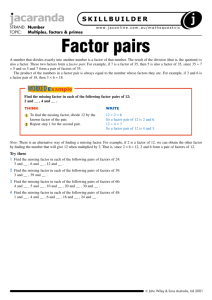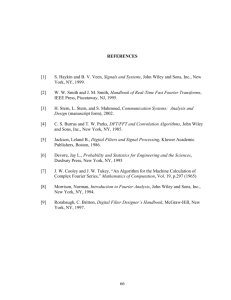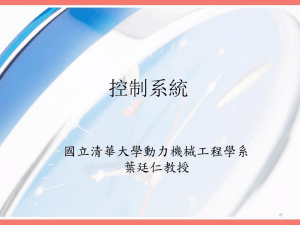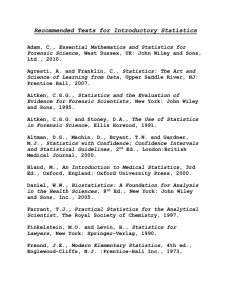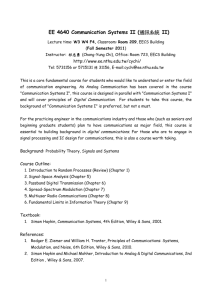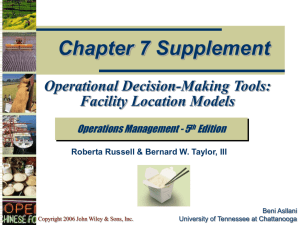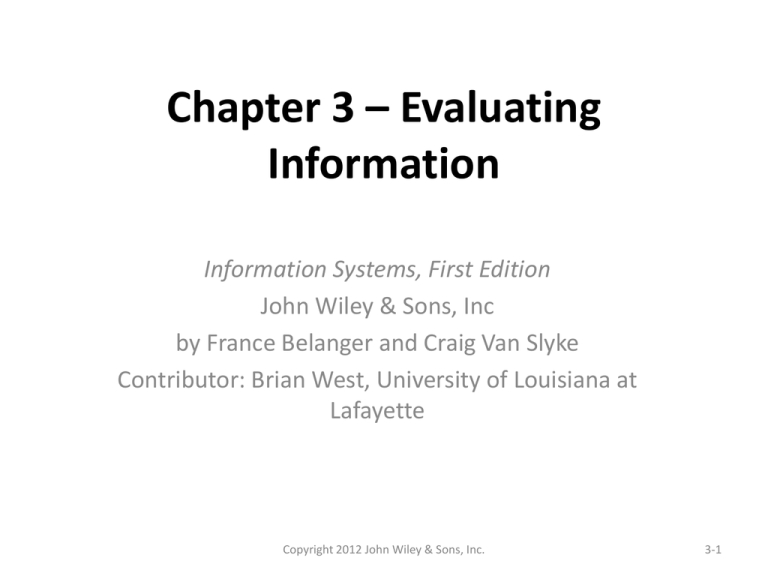
Chapter 3 – Evaluating
Information
Information Systems, First Edition
John Wiley & Sons, Inc
by France Belanger and Craig Van Slyke
Contributor: Brian West, University of Louisiana at
Lafayette
Copyright 2012 John Wiley & Sons, Inc.
3-1
Learning Objectives
• Discuss why it is important both personally and
professionally to be an informed information consumer
• Describe information overload, its consequences and
approaches for dealing with information overload
• Discuss the relationship between information overload
and information evaluation
• List and describe the dimensions of information quality
• List and describe the elements of an information
evaluation framework
• Given an information-related task, evaluate
information for its usefulness and believability
Copyright 2012 John Wiley & Sons, Inc.
3-2
Biased Information in a trusted outlet
Information is often biased, sometimes intentionally,
sometimes unintentionally. A particular article was about
an output device called a plotter. A plotter is used to
produce large-format drawings, such as architectural and
engineering plans.
The article was very positive about a plotter that used
pencils rather than inkjet or laser. Inkjet and laser-like
plotters were much faster than pencil plotters and more
versatile.
The author was the national marketing manager for the
only company that manufactured pencil plotters (at that
time).
Copyright 2012 John Wiley & Sons, Inc.
3-3
Focusing Questions
Making these decisions based on biased or
otherwise low-quality information can lead to
serious consequences, such as spending
thousands of dollars on an inferior plotter.
• Give two examples of instances where you
encountered biased information. What made
you think the information was biased?
• What are some of the consequences of relying
on biased information?
Copyright 2012 John Wiley & Sons, Inc.
3-4
Being a smart information consumer
• Being successful in today’s knowledge society
requires being a good information consumer
• The goal of this chapter is to help you improve
your information evaluation skills.
___________________: The systematic
determination of the merit and worth of
information.
Copyright 2012 John Wiley & Sons, Inc.
3-5
Evaluating Information
• One of the great things about the Internet is that
there are almost no “_____________” who
determine what can be posted.
• This means that there is no quality control
• In more traditional media, the responsibility for
evaluating the quality and correctness of
information was the job of editors and publishers.
• With the Internet, that responsibility shifts to the
information consumer
Copyright 2012 John Wiley & Sons, Inc.
3-6
Evaluating Information
• In business, we often use information to
reduce uncertainty
• The more uncertainty, the more we seek
information in order to reduce that
uncertainty
•
Copyright 2012 John Wiley & Sons, Inc.
3-7
My online life
We all face a daily torrent of information. The more
“connected” you are, the more information you
face. As you go throughout the next day, pay
attention to how you deal with the information you
face each day
• What strategies do you use to determine what
information is important and to reduce the
amount of information you deal with?
• How successful are these strategies?
• How could you improve your approach to
information filtering?
Copyright 2012 John Wiley & Sons, Inc.
3-8
Information Overload
___________________: Being faced with more
information than one can effectively process.
• The more information we have to sift through,
the less attention we have to devote to other
tasks
• It reduces productivity, increases stress and
can actually lead to physical health problems.
Copyright 2012 John Wiley & Sons, Inc.
3-9
Information Overload
Managers know the value of information and
gather information for many different reasons
• In a belief that more information improves
decision making
• To justify decisions
• To verify previously-acquired information
• To “play it safe” by making sure they do not miss
any relevant information
• In the belief that the information may be useful
later
Copyright 2012 John Wiley & Sons, Inc.
3-10
Dealing with Information Overload
Two major strategies for dealing with information
overload are filtering and withdrawal
• Withdrawal essentially involves disconnecting
from sources of information; not checking email,
turning off the television, not surfing the Web
and so on
• Filtering information involves knowing what
information we need and what information
merits attention and use, which makes knowing
how to evaluate information a critical skill in
today’s information rich world
Copyright 2012 John Wiley & Sons, Inc.
3-11
Dimensions of Information Quality
There are many views on what constitutes “high
quality” information. Search the Web to
discover different views on the dimensions of
information quality.
• What, in your opinion, are the three most
important dimensions of information quality?
• Why do you think these are the most
important?
Copyright 2012 John Wiley & Sons, Inc.
3-12
Information Quality
• Garbage in, garbage out
• If you use bad information as the basis for a
decision, you are probably going to make a
bad decision
• Dimensions of information quality; the
characteristics of information that make it
useful or not useful.
Copyright 2012 John Wiley & Sons, Inc.
3-13
Dimensions of Information Quality
• Intrinsic quality includes dimensions of quality
that are important regardless of the context or
how the information is represented.
• Contextual quality includes the dimensions that
may be viewed differently depending on the task
at hand.
• Representational quality concerns how the
information is provided to the user.
• Accessibility quality has to do with whether
authorized users can easily access the
information.
Copyright 2012 John Wiley & Sons, Inc.
3-14
Information Quality
Information
Quality
Intrinsic
Contextual
Figure 3.1 Information Quality Dimensions
Copyright 2012 John Wiley & Sons, Inc.
3-15
Intrinsic Dimension
Intrinsic Dimension
Definition: Extent to which the information is:
Accurate
Believable
Objective
Understandable
Consistent
Copyright 2012 John Wiley & Sons, Inc.
3-16
Contextual Dimension
Contextual Dimension
Definition: Extent to which the information is:
Relevant
Timely
Complete
Current
Copyright 2012 John Wiley & Sons, Inc.
3-17
Information Quality
• There needs to be emphasis on the
importance of considering context when
thinking about information quality.
• Consider stock price information. It is common
for free information services to delay stock
price information by fifteen minutes.
• This is acceptable for a casual investor but
devastating for a day trader
Copyright 2012 John Wiley & Sons, Inc.
3-18
Quality Costs
• On the surface, it may seem like we should
want the highest quality information possible
• Few individuals or organizations are willing to
invest the resources necessary to ensure the
highest possible information quality.
• We want information that is of sufficient
quality to carry out tasks effectively.
• In other words, we want “good enough”
information quality.
Copyright 2012 John Wiley & Sons, Inc.
3-19
Evaluating information sources
You are thinking about investing in real estate.
While doing some initial research you obtained
the following sources of information
• A 2004 book on investing in residential real estate
• A local real estate broker
• A database of historical sales prices from your local tax
collector
Rank these three sources based on how willing
you would be to rely on the information from
the source. Briefly justify your rankings.
Copyright 2012 John Wiley & Sons, Inc.
3-20
Evaluating Information
Now that you understand a bit about
information quality, the question of how to
evaluate information comes into play
• Is the information useful?
• Is the information believable?
Useful?
• Relevant
• Appropriate
• Current
Believable?
•
•
•
•
Credible
Objective
Supported
Comprehensive
Copyright 2012 John Wiley & Sons, Inc.
3-21
Evaluating Usefulness
• If the information is not useful, then there is
no need to assess its believability.
• To determine whether information is useful,
evaluate whether the information is relevant,
appropriate and sufficiently current.
• Each of these is a “____________”
assessment.
Copyright 2012 John Wiley & Sons, Inc.
3-22
Evaluating Relevance
• Information relevance is the degree to which the
information is pertinent to the task at hand.
• Will this information help me accomplish my
task?
• There are varying degrees of relevance
• With experience you will be able to determine
what degree of relevance merits further
evaluation
• Context-dependent
Copyright 2012 John Wiley & Sons, Inc.
3-23
Evaluating Appropriateness
• Is the information suitable for your purpose?
• You will need to assess the level of detail and the
depth of the information in light of your
information needs.
• If you are researching a new technology when
preparing a report for your manager, the
information contained in a high school student’s
report may not be appropriate for your use
• Context-dependent
Copyright 2012 John Wiley & Sons, Inc.
3-24
Evaluating Currency
• How current you need the information to be?
• If you are seeking information related to
rapidly evolving topics, such as information
technology, you may need information that is
very up-to-date
• Determining the currency of Web-based
information is often difficult
Copyright 2012 John Wiley & Sons, Inc.
3-25
Evaluating Credibility
• Evaluating the credibility of an information source
can be tricky in many cases and relatively
straightforward in others
• More formal publications, such as peer-reviewed
journals, often include short author biographies
• If the author has written widely on the topic in
reputable sources, s/he probably has sufficient
expertise to merit using the information
Copyright 2012 John Wiley & Sons, Inc.
3-26
Evaluating Objectivity
• First consider the source of the information
• Using factual information from Dell’s Website
is fine, but relying on Dell to provide an
unbiased comparison of their computers to
Hewlett-Packard’s is a bad idea
• Language that is more fact-based and neutral
is more likely to be objective
Copyright 2012 John Wiley & Sons, Inc.
3-27
Evaluating Support
• Claims without support should not be trusted
• When support is offered, you should evaluate
the quality of the support
• Consider the reasonableness of the claim
• The claim should be testable
• This does not mean that you have to actually
test the claim, but if you can see no
reasonable way to test the claim be reluctant
to rely on the information.
Copyright 2012 John Wiley & Sons, Inc.
3-28
Evaluating Comprehensiveness
• Assessing comprehensiveness requires
assessing the depth and breadth of the
information.
• Breadth concerns whether all aspects of a
topic are covered while depth concerns the
level of detail provided.
• Look for obvious gaps in information.
• Throughout your evaluation, keep in mind the
context of your particular task
Copyright 2012 John Wiley & Sons, Inc.
3-29
Summary
• Being able to evaluate information is a key element of information
literacy, which is an important skill for both our professional and
personal lives.
• Career and personal success depends, in part, on the outcomes of
the decisions we make. Our ability to evaluate the information we
use to make these decisions affects the quality of our decisions.
• Information overload occurs when we are faced with more
information than we can effectively process.
• Increasing our information evaluation skills helps us deal with
information overload by reducing the amount of attention and time
we devote to low-quality or non-useful information.
• Intrinsic dimensions of information quality include accuracy,
believability, objectivity and consistency.
Copyright 2012 John Wiley & Sons, Inc.
3-30
Summary
• Contextual dimensions of information quality
include relevance, timeliness, completeness and
currency.
• Evaluating information concerns determining
whether the information is useful and believable.
• Useful information is relevant, appropriate and
sufficiently current for the task at hand.
• Believable information is credible, objective, wellsupported and comprehensive.
Copyright 2012 John Wiley & Sons, Inc.
3-31
Copyright 2012 John Wiley & Sons, Inc.
All rights reserved. Reproduction or translation of this
work beyond that permitted in section 117 of the 1976
United States Copyright Act without express permission
of the copyright owner is unlawful. Request for further
information should be addressed to the Permissions
Department, John Wiley & Sons, Inc. The purchaser may
make back-up copies for his/her own use only and not for
distribution or resale. The Publisher assumes no
responsibility for errors, omissions, or damages caused by
the use of these programs or from the use of the
information herein.
Copyright 2012 John Wiley & Sons, Inc.
3-32

